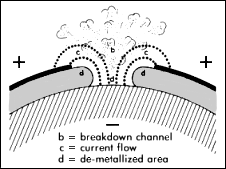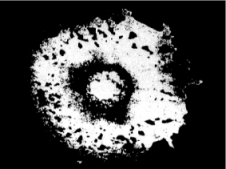|
您的位置: 首 页 技术支持 技术支持 Self-healing Process in Metallized Capacitors Self-healing Process in Metallized Capacitors
Self-healing Process in Metallized Capacitors
Even the best
plastic films, like ceramic materials, are not free from
pin-holes.
However, in the case of metallized film
capacitors it is possible to eliminate these faults by
applying a much higher voltage than the rated voltage. This
process is known as self-healing and
practically makes a "zero defect dielectric"
possible. |
| |

Figure 1:
Schematic representation of the self-healing process
|
|

Figure 2:
Isolated area after the self-healing process
|
| |
|
The self-healing process
is started by an electric breakdown, which takes about
10-8 secs. In the breakdown channel, the dielectric
is transformed into a highly compressed plasma which is pushed
out of the channel and presses the dielectric layers apart
(figure 1).
In the spreading plasma,
discharging continues over the metal electrodes. Temperatures
of approximately 6000 K occur and insulated areas are formed
around the original failure spot (figure 2). This self-healing
process takes a few μsec and the discharging in the plasma has
already ceased before a greater loss of voltage takes place.
This quick extinction of the plasma is necessary to avoid
further damage to the dielectric layer next to the point of
failure.
The pressure between the layers must not be too
great, so that the plasma can spread out from the breakdown
channel quickly. Large parts of the plasma get into areas of
low field strength.
The flawless course of
the self-healing process depends on the thickness of
the metallization, on the chemical
composition and on the rate of the applied
voltage; here, apart from the chemical composition,
the production conditions have to provide the prerequisites
for optimum self-healing.
Self-healing behaviour as a quality
standard. |
| |
|
